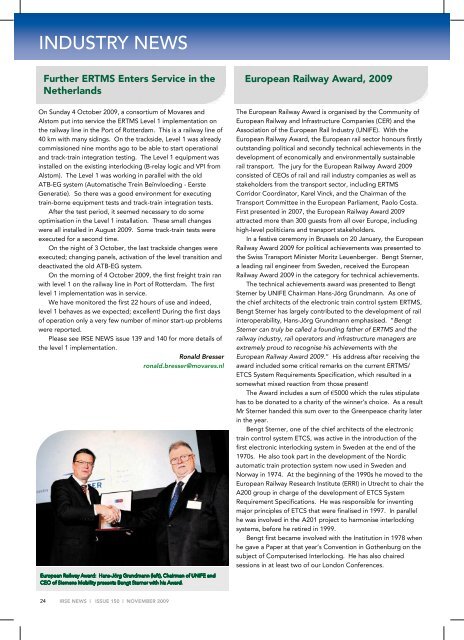IRSE News 150 Nov 09.pdf
IRSE News 150 Nov 09.pdf
IRSE News 150 Nov 09.pdf
Create successful ePaper yourself
Turn your PDF publications into a flip-book with our unique Google optimized e-Paper software.
INDUSTRY NEWS<br />
Further ERTMS Enters Service in the<br />
Netherlands<br />
European Railway Award, 2009<br />
On Sunday 4 October 2009, a consortium of Movares and<br />
Alstom put into service the ERTMS Level 1 implementation on<br />
the railway line in the Port of Rotterdam. This is a railway line of<br />
40 km with many sidings. On the trackside, Level 1 was already<br />
commissioned nine months ago to be able to start operational<br />
and track-train integration testing. The Level 1 equipment was<br />
installed on the existing interlocking (B-relay logic and VPI from<br />
Alstom). The Level 1 was working in parallel with the old<br />
ATB-EG system (Automatische Trein Beïnvloeding - Eerste<br />
Generatie). So there was a good environment for executing<br />
train-borne equipment tests and track-train integration tests.<br />
After the test period, it seemed necessary to do some<br />
optimisation in the Level 1 installation. These small changes<br />
were all installed in August 2009. Some track-train tests were<br />
executed for a second time.<br />
On the night of 3 October, the last trackside changes were<br />
executed; changing panels, activation of the level transition and<br />
deactivated the old ATB-EG system.<br />
On the morning of 4 October 2009, the first freight train ran<br />
with level 1 on the railway line in Port of Rotterdam. The first<br />
level 1 implementation was in service.<br />
We have monitored the first 22 hours of use and indeed,<br />
level 1 behaves as we expected; excellent! During the first days<br />
of operation only a very few number of minor start-up problems<br />
were reported.<br />
Please see <strong>IRSE</strong> NEWS issue 139 and 140 for more details of<br />
the level 1 implementation.<br />
Ronald Bresser<br />
ronald.bresser@movares.nl<br />
European Railway Award: Hans-Jörg Grundmann (left), Chairman of UNIFE and<br />
CEO of Siemens Mobility presents Bengt Sterner with his Award.<br />
The European Railway Award is organised by the Community of<br />
European Railway and Infrastructure Companies (CER) and the<br />
Association of the European Rail Industry (UNIFE). With the<br />
European Railway Award, the European rail sector honours firstly<br />
outstanding political and secondly technical achievements in the<br />
development of economically and environmentally sustainable<br />
rail transport. The jury for the European Railway Award 2009<br />
consisted of CEOs of rail and rail industry companies as well as<br />
stakeholders from the transport sector, including ERTMS<br />
Corridor Coordinator, Karel Vinck, and the Chairman of the<br />
Transport Committee in the European Parliament, Paolo Costa.<br />
First presented in 2007, the European Railway Award 2009<br />
attracted more than 300 guests from all over Europe, including<br />
high-level politicians and transport stakeholders.<br />
In a festive ceremony in Brussels on 20 January, the European<br />
Railway Award 2009 for political achievements was presented to<br />
the Swiss Transport Minister Moritz Leuenberger. Bengt Sterner,<br />
a leading rail engineer from Sweden, received the European<br />
Railway Award 2009 in the category for technical achievements.<br />
The technical achievements award was presented to Bengt<br />
Sterner by UNIFE Chairman Hans-Jörg Grundmann. As one of<br />
the chief architects of the electronic train control system ERTMS,<br />
Bengt Sterner has largely contributed to the development of rail<br />
interoperability, Hans-Jörg Grundmann emphasised. “Bengt<br />
Sterner can truly be called a founding father of ERTMS and the<br />
railway industry, rail operators and infrastructure managers are<br />
extremely proud to recognise his achievements with the<br />
European Railway Award 2009.” His address after receiving the<br />
award included some critical remarks on the current ERTMS/<br />
ETCS System Requirements Specification, which resulted in a<br />
somewhat mixed reaction from those present!<br />
The Award includes a sum of €5000 which the rules stipulate<br />
has to be donated to a charity of the winner’s choice. As a result<br />
Mr Sterner handed this sum over to the Greenpeace charity later<br />
in the year.<br />
Bengt Sterner, one of the chief architects of the electronic<br />
train control system ETCS, was active in the introduction of the<br />
first electronic interlocking system in Sweden at the end of the<br />
1970s. He also took part in the development of the Nordic<br />
automatic train protection system now used in Sweden and<br />
Norway in 1974. At the beginning of the 1990s he moved to the<br />
European Railway Research Institute (ERRI) in Utrecht to chair the<br />
A200 group in charge of the development of ETCS System<br />
Requirement Specifications. He was responsible for inventing<br />
major principles of ETCS that were finalised in 1997. In parallel<br />
he was involved in the A201 project to harmonise interlocking<br />
systems, before he retired in 1999.<br />
Bengt first became involved with the Institution in 1978 when<br />
he gave a Paper at that year’s Convention in Gothenburg on the<br />
subject of Computerised Interlocking. He has also chaired<br />
sessions in at least two of our London Conferences.<br />
24<br />
<strong>IRSE</strong> NEWS | ISSUE <strong>150</strong> | NOVEMBER 2009

















